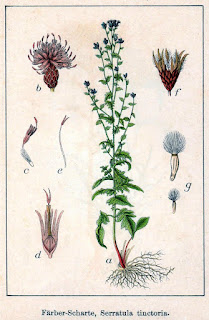Bij Marie-Claire Bouttier op bezoek tijdens onze kruidenstage. Siropen gemaakt met vlierbloesem, lavendel, tijm, rozemarijn zijn haar klassiekers maar ook siroop van rozen, kastanjebloemen en bonenkruid kun je er vinden.
Over het bonenkruid heb ik nog niet veel geschreven, toch is het een waardevol kruid: eetlustopwekkend, spijsverteringbevorderend, stimulerend en bacteriedodend. Satureja montana is een laag heestertje en is zowel wat teelt als medicinale werking betreft enigszins te vergelijken met tijm.
Over bergbonenkruid of doorlevend bonenkruid / Satureja montana
De Latijnse benaming komt van de saters, wezens half mens half beest met buitensporige seksuele appetijt. In Frankrijk is de plant als afrodisiacum bekend. De Romeinen gebruikten het kruid veelvuldig en brachten het naar Engeland, van waaruit het algemeen werd verbreid. Het is een van de oudste potentieverhogende middelen, in de Middeleeuwen was het zelfs verboden voor de monniken. Ook de Oude Grieken kenden de plant al en Virgilius roemde het om zijn geur en gaf de raad om het in de buurt van bijenkorven te houden.
Info uit de monografie van Natural Standard
Savory has been used traditionally as a digestive remedy for colic and diarrhea, as an ingredient in love potions, and as an antimicrobial. Uses for summer savory include as a stimulant, carminative, and emmenagogue. Winter savory is believed to relieve asthma symptoms. Based on secondary sources, savory may be used as a warm infusion for the treatment of colds, menstrual suppression, and flatulent colic. A cold infusion may be used as a gentle stimulating tonic during fever. Savory oil has been applied locally for the relief of toothache. Its tincture is used as a carminative.
The essential oil of Satureja montana completely inhibited germination of crops (Raphanus sativus, Capsicum annuum, Lactuca sativa) and weeds (Chenopodium album, Portulaca oleracea, Echinochloa crus-galli). Carvacrol, a constituent of savory, has been used as a feed additive in honeybee breeding.
Some Satureja montana extracts selectively inhibited the growth of human tumor cell lines, including HeLa (human cervix epidermoid carcinoma), and HT-29 (human colon adenocarcinoma), but not MCF-7 (human breast adenocarcinoma).
Wat wetenschappelijk onderzoek voor verdere studie
Hajhashemi, V., Ghannadi, A., and Pezeshkian, S. K. Antinociceptive and anti-inflammatory effects of Satureja hortensis L. extracts and essential oil. J Ethnopharmacol. 2002;82(2-3):83-87.
Cetojevic-Simin, D. D., Bogdanovic, G. M., Cvetkovic, D. D., and Velicanski, A. S. Antiproliferative and antimicrobial activity of traditional Kombucha and Satureja montana L. Kombucha. J BUON. 2008;13(3):395-401.
Cetojevic-Simin, D. D., Canadanovic-Brunet, J. M., Bogdanovic, G. M., Cetkovic, G. S., Tumbas, V. T., and Djilas, S. M. Antioxidative and antiproliferative effects of Satureja montana L. extracts. J BUON. 2004;9(4):443-449
Higes, Pascual M., Suarez, Robles M., Llorente, Martinez J., Paya Vicens, M. T., and Vicente, Montana A. [Efficiency of essential oil (Satureja montana) in controlling the ascospherosis in the honey bee (Apis mellifera) under field conditions.]. Rev.Iberoam.Micol. 1998;15(3):151-154.
Yazdanparast, R. and Shahriyary, L. Comparative effects of Artemisia dracunculus, Satureja hortensis and Origanum majorana on inhibition of blood platelet adhesion, aggregation and secretion. Vascul.Pharmacol 2008;48(1):32-37.
Hajhashemi, V., Sadraei, H., Ghannadi, A. R., and Mohseni, M. Antispasmodic and anti-diarrhoeal effect of Satureja hortensis L. essential oil. J Ethnopharmacol. 2000;71(1-2):187-192.














+-+kopie.JPG)






















+-+kopie.JPG)






+-+kopie.JPG)






